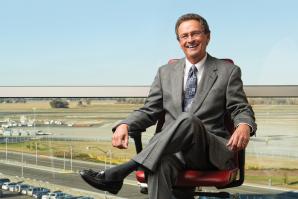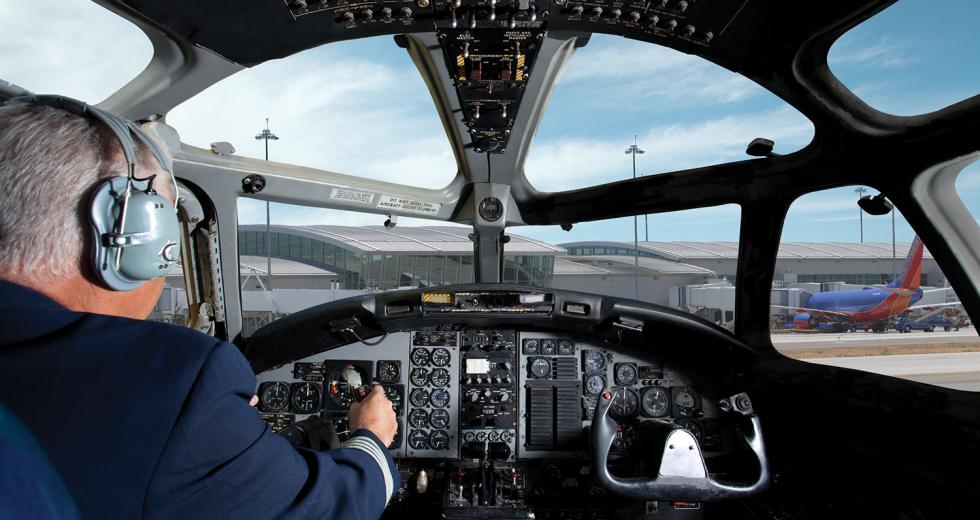In September 2008, when Lehman Brothers collapsed and the municipal bond market froze, Sacramento International Airport had just begun constructing the biggest capital improvement project in the county’s history.
County Airport Director Hardy Acree, who retires in December, remembers the following weeks as a “nightmare.” The economy was in a tailspin, the entire air travel industry was reeling from a spike in jet fuel costs, and Acree and his team suddenly were unable to move forward with the highly publicized $1.3 billion project.
But there was no turning back. The terminal had been under development for five years; $585 million in combined revenue bonds were issued in May 2008, and construction had started in June. Acree pushed on, despite concerns from the press and public that the project was overly ambitious.
“If you’re setting out to build an aircraft carrier, and you’ve done all the design and planning and you have all the contracts in there, you’re halfway through the process. You don’t convert that into building a 100-foot yacht,” Acree says. “It’s not a switch that you turn on and off, scale up and scale down. Once you’re committed, once you sell those bonds … you’re pregnant.”
To give birth to the Terminal B project, Acree worked out a plan with the project’s contractors to rearrange the construction schedule until another bond sale was possible. That bought some time and kept the entire project afloat. Over the following six months, airport officials postponed a $161 million parking garage and eliminated a 185-room hotel planned to sit atop the terminal building. That move saved $78 million (the airport relies on internal revenues and federal grants, not local taxpayer dollars).
Those actions took care of financing, but the four-story, 740,000-square-foot Terminal B project continues to struggle with low passenger traffic. Some industry observers question the logic of pushing higher costs on airlines with the construction of a modern terminal.
“It’s like you built a product that was wonderful for 2005 thinking. 2015 thinking says, ‘We’re not coming there,’” says Joe Brancatelli, editor of joesentme.com, a website for business travelers.
“Who is going to use it?” he asks. “You’re banking on future growth in an industry that is literally shrinking. The airline industry is about 5 percent smaller now. It’s not like [airlines] won’t add new service, but I don’t know that it will be in Sacramento.”
Brancatelli adds the caveat that he is a national aviation industry observer with minimal knowledge of the Sacramento market. However, he speaks to the fact that the post-recession years have seen the biggest fall in commercial air travel since 9/11. In January 2012, Moody’s credit ratings agency gave the entire U.S. airport industry a negative outlook, citing factors such as the weak global economy, uncertainty around future federal funding and ongoing airline consolidations.
Unfortunately, Sacramento International has been swept into the vortex.
In 2004, when the county Board of Supervisors approved a draft plan of the new terminal, the airport served about 4.8 million enplanements, or outbound passengers. Forecasts at the time showed Sacramento International would serve about 5.8 million enplaning passengers in 2010, but that year it served just 4.4 million. The Federal Aviation Administration now predicts enplanements will not return to 2007 levels until 2018.
The plummeting number of Sacramento travelers is believed to have bottomed out last year at 4.3 million enplanements. As of August 2012, that number is up about half a percent.
To understand the unique challenge facing Sacramento, consider that enplanements at San Francisco International slowed but never fell after 2008. That’s due in large part to the fact that San Francisco operates 23 international air carriers; Sacramento operates one.
Aviation industry observers note that the recession had no major impact on the travel habits of wealthy families — they continued to enjoy Champagne tours in Paris and Tanzanian safaris.
“In our business, what got hit more was the Disneyland, Vegas, Hawaii to some degree — things that were more of a middle-class trip,” says Trudy Flores, a travel agent with TravelStore. “And kind of the same thing happened in corporate. It was a little bit of the necessary travel (that) still went on, and a lot of heavy hitters in the executive (suite) were still doing their practically-around-the-world every month. And sales were still happening.”
Back in Sacramento, the median household income was pegged last year at just over $55,000 — a 15 percent drop from the 2007 level. This is partly due to ongoing reductions in the public sector. And recall that a ban on all “nonessential travel” for state workers has endured for the past three governors, though it became much stricter in recent years.
“You’re banking on future growth in an industry that is literally shrinking. The airline industry is about 5 percent smaller now. It’s not like [airlines] won’t add new service, but I don’t know that it will be in Sacramento.”
Joe Brancatelli, editor, joesentme.com
Acree, meanwhile, has referred to intrastate travel as the airport’s “bread and butter.”
Although Sacramento International now carries a debt load of $1.1
billion (senior lien plus subordinate), the airport remains in
good credit. In late September, the credit ratings agency
Standard and Poor reaffirmed an A/Stable rating.
Airport operators largely achieved that solid credit score by installing new revenue structures before the expansion started, including raising airport parking fees. Passengers still also pay a $4.50 ticket surcharge that has been in effect since 1993 and helps pay off Terminal A, which opened in 1998. The airport also charges fees on car rentals.
But the biggest fee increase has been directed at the lease rates paid by the airlines. The cost per enplanement is projected to be between $18 and $19 in fiscal 2012/2013, up from $6 per passenger prior to 2008.
The airlines bemoaned the move and still contend that Sacramento’s high costs are a burden. It costs “significantly less” money to serve passengers in San Francisco and Oakland, says Kevin Costello, a spokesman for JetBlue.
“The reality is that [Sacramento has] a big annual debt service to overcome,” he says. “It makes it sort of difficult for an airline to continue to be profitable when costs continue to go up.”
Costello credits Acree and his company for an “admirable” job in cutting expenses where possible, but his comments left no indication that JetBlue is planning to increase service in Sacramento.
Airport officials in September announced the arrival of the Mexican airline Volaris with flights to Guadalajara, bringing new competition to Aeromexico, which already offered that destination. Also that month, Denver-based Frontier Airlines announced it was eliminating service from Sacramento International.
Eventually, the airport hopes to bring in new destinations, though that effort is not essential to maintaining a solid credit score.
“The financing plan here is not in eminent danger of being insufficient. It can survive for a number of years. Eventually, if you didn’t have growth in enplanements or parking fees and things like that, you would have to make some real adjustments,” says Assemblyman Roger Dickinson (D-Sacramento), who, as a county supervisor over the past decade, was instrumental in designing and launching Terminal B.
Dickinson also argues that the terminal expansion was essential, regardless of current passenger numbers. The old terminal did not have the proper amenities for security equipment made after 9/11; the concourses were too narrow, the seating too tight, and the space for concessions was not up to contemporary standards, he says.
Despite airlines’ concerns, Sacramento needed an impressive terminal to attract major airlines says the Assemblyman.
“I think some people look today and say, ‘Look at the terminal,
it’s not all that occupied.’ That’s not the point,” Dickinson
says. “The point is that we built a facility and created a design
that can accommodate our air travel needs from a passenger-
facilities standpoint for decades to come. We don’t have to
build, literally, for the next 50 years.”
Did you know?
Sacramento International Airport provides 3,000 jobs and has a payroll of $160 million. The annual economic impact to the region is estimated at $4 billion, meaning that’s how much airport staff and incoming visitors spend in the Capital Region. Beyond the numbers, there are certain economic ‘intangibles’ the airport system provides, explains Ryan Sharp, director of the Center for Strategic Economic Research. “They’re a business asset that is something important in the matrix of all business considerations, and also in attracting residents. It’s a quality of life feature,” he says.
Recommended For You

Ace Analyst
Acuity with Director of Airports John Wheat
John Wheat, 63, was named director of airports for the Sacramento County Airport System in April, 2013.
Payload Denied
Dwindling shipments jeopardize air cargo facilities
The air cargo industry has long been a valuable component in the Capitol Region’s economy. But in spite of some rosy growth projections, air freight traffic in the region has been in a steady decline for more than a decade with no sure signs it will return to its former prominence.



